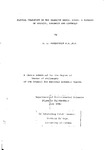FLUVIAL TRANSPORT IN THE NARRATOR BROOK, DEVON: A SUMMARY OF SOURCES, DYNAMICS AND CONTROLS
| dc.contributor.author | Murgatroyd, A.L. | |
| dc.contributor.other | School of Geography, Earth and Environmental Sciences | en_US |
| dc.date.accessioned | 2013-09-17T09:01:35Z | |
| dc.date.available | 2013-09-17T09:01:35Z | |
| dc.date.issued | 1980 | |
| dc.identifier | NOT AVAILABLE | en_US |
| dc.identifier.uri | http://hdl.handle.net/10026.1/1769 | |
| dc.description.abstract |
The Narrator Brook drains a catchment area of 4.68 km² which is entirely underlain by granite and which includes-moorland, improved pasture and coniferous forest plantation. Observations of suspended sediment and solute transport by the Narrator Brook are based on stream sampling combined with laboratory analysis. Bedload transport is measured by trap sunk into the stream bed. Respective yields of solutes, suspended sediment and bedload over the 19 months of observation (25/5/75 to 13/12/76) are 12.6 t/km², 4.0 t/km² and 0.1 t/km². Afforestation in the Narrator catchment is responsible for accelerating the rate of bank erosion and this has contributed significantly to the sediment transported by the Narrator Brook. Soil well observations indicate that overland flow is both frequent and widespread in the Narrator catchment suggesting that catchment slopes also constitute a major source of sediment. With respect to the sources for solutes transported by the Narrator Brook, the atmosphere supplies 70.1% with the remaining 29.9% originating from rock weathering in the catchment. Suspended sediment dynamics are characterised by clockwise hysteresis and higher concentrations in summer for a given discharge than in winter. This, combined with the emergence from multiple regression analysis of precipitation intensity as the predominant control, of suspended sediment concentration, reflects the importance of catchment slopes as a source of suspended sediment. Analysis of variations in solute concentration reveals the existence of both flushing and chemical buffering mechanisms in the Narrator catchment. Suspended sediment yield is greatest below the region of improved pasture in the Narrator catchment and least below the moorland region of the catchment. Solute production is more uniform over the Narrator catchment than suspended sediment production but is slightly higher in the forested region than elsewhere. In the upper reaches of the Narrator Brook baseflow suspended sediment and solute concentrations are influenced by outflow from marshes which border the stream. In the lower reaches downstream variations in baseflow suspended sediment and solute concentration are determined respectively by channel gradient and area of catchment forested. | |
| dc.description.sponsorship | Birkbeck College, University of London | en_US |
| dc.language.iso | en | en_US |
| dc.publisher | University of Plymouth | en_US |
| dc.title | FLUVIAL TRANSPORT IN THE NARRATOR BROOK, DEVON: A SUMMARY OF SOURCES, DYNAMICS AND CONTROLS | en_US |
| dc.type | Thesis | |
| plymouth.version | Full version | en_US |
| dc.identifier.doi | http://dx.doi.org/10.24382/4012 | |
| dc.identifier.doi | http://dx.doi.org/10.24382/4012 |
Files in this item
This item appears in the following Collection(s)
-
01 Research Theses Main Collection
Research Theses Main


